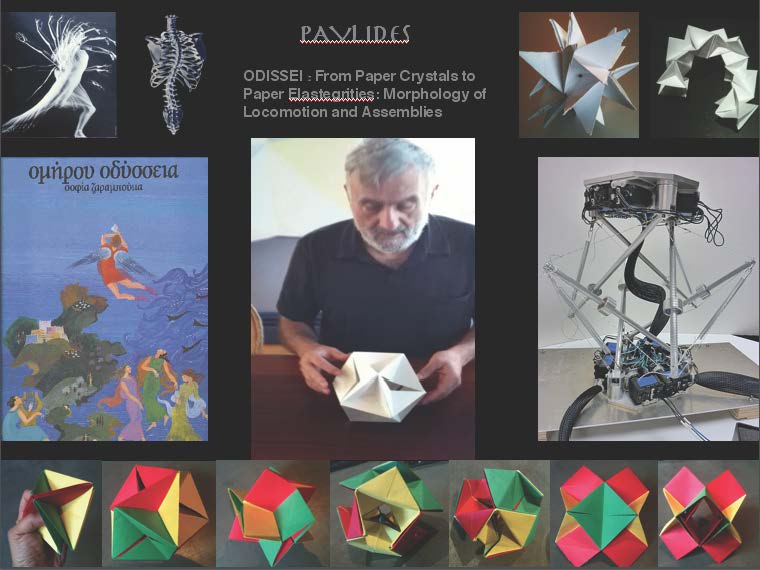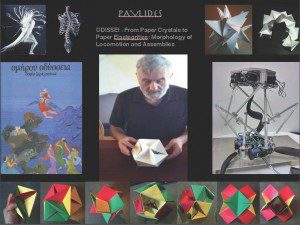
09 Aug ART ILLUMINATING SCIENCE: FROM PAPER CRYSTALS TO THE ARCHITECTURE OF LIFE
Editor’s Note: We first met Architecture Professor Lefteris Pavlides, PhD, AIA, his wife Stephanie, also an architect, and their genius offspring, Odysseas, Fall, 2010 on Crete. After several unforgettable days touring with them to discover the island – you can type “Crete” into Search on our Home Page and read all about it – we architected a friendship that won’t quit. One of the many wonders of Lefteris is his paper crystals and the powerful ideas they hold within their prisms. On a brief visit to town, through The Ah Haa School for the Arts, Lefteris is offering hands-on workshop & lecture, “Art Illuminating Science: From Paper Crystals to the Architecture of Life.” The two-hour FREE intensive takes place Monday, August 13, 2 – 4 p.m. in the Stone Building on Willow Street. Here’s what Lefteris wrote about the class.
 Elast*egrities. These curious elastic structures – which maintain integrity of form by resisting the push and pull of external forces with internal elastic forces – will be the focus of my paper-folding workshop and lecture. Over a two-hour period, we will fold and weave paper into squeezable assemblies of rigid and elastic members that shape-shift into rock solid structures when pressed between the fingers, but spring back into their original form when released.
Elast*egrities. These curious elastic structures – which maintain integrity of form by resisting the push and pull of external forces with internal elastic forces – will be the focus of my paper-folding workshop and lecture. Over a two-hour period, we will fold and weave paper into squeezable assemblies of rigid and elastic members that shape-shift into rock solid structures when pressed between the fingers, but spring back into their original form when released.
Elastegrities were a surprising outgrowth of weaving a rigid paper diamond, which I first conceived of nearly 35 years ago. Workshop participants will create variations of rigid paper crystals and elastegrities. We will reflect on how these structures may relate to the architecture of life, from the cytoskeleton (architecture of living cells) to the musculoskeleton (architecture of muscles and bones).
Researchers, including the director of Harvard’s Wyss Institute, Donald E. Ingber, M.D., Ph.D., and renowned orthopedic surgeon Steven D. Levin, M.D., have explored relatives of elastegrities, which hold integrity of form through tension alone. Their name? Tens•egrities, of course.
Both Ingber and Levin have said seeing “The Needle”, a tensegrity by Kenneth Snelson, who first invented tensegrities at the Hirshhorn Sculpture Garden, was a life-altering experience that opened avenues for research, a true example of art illuminating science. However elastegrities, according to Levin, may be more suited than tensegrities to explain the shape-shifting nature of the cytoskeleton and why the skull does not wobble as we walk.
Last fall, I put together a team of nine synergists that includes four engineers, an orthopedic surgeon, an Alexander Technique master, and two visual artists to join me in further exploring elastegrities through an NSF grant. I am currently working on a formal paper with my collaborators and on a book to present our most recent findings and also the results of decades of discovery that came before. In 2012, I taught a new course on Morphology, Structure, Materials, and the Architecture of Form at Roger Williams School of Architecture, where I work.
Note: Lefteris’ workshop is FREE to the general public. Questions? Call Ah Haa, 970-728-3886.


Sorry, the comment form is closed at this time.